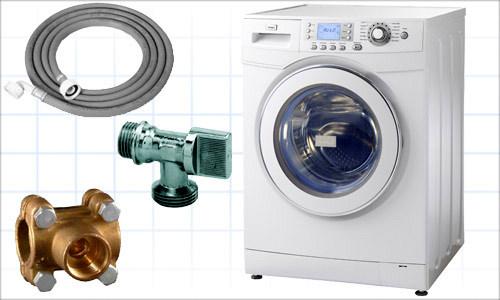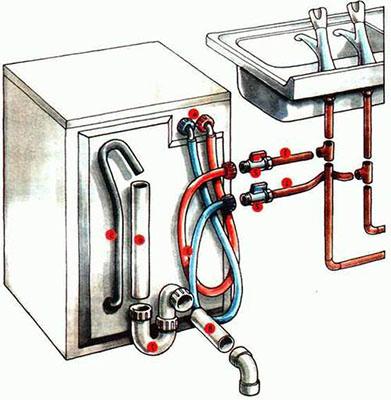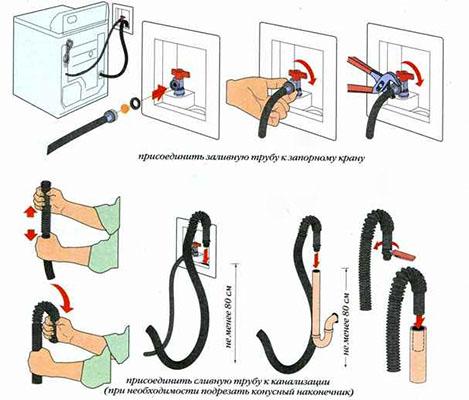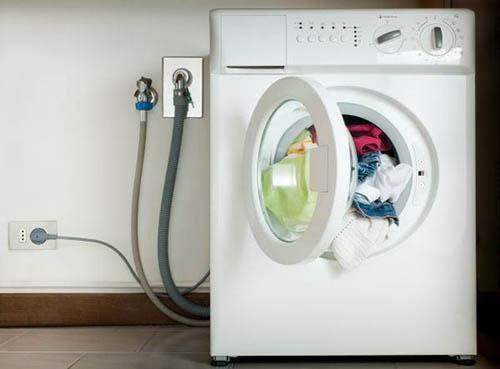When buying an automatic washing machine, we immediately try to ask the seller who can install it? In fact, almost every person who is not afraid to touch the tools will be able to cope with this task.
Connecting the washing machine to the water supply and sewerage can be done in just a couple of hourssaving money on calling a specialist.
The installation process includes several steps:
- Finding a suitable place;
- Initial preparation of the machine;
- Plumbing preparation;
- Preparation of the drain system;
- Unit testing.
After all the stages have been successfully completed, you can safely proceed to the operation of the washing machine.
Preparing to connect the machine

At the first stage, we need to find the most suitable place for the purchased washing machine. It all depends on the preferences of the end user. If it is possible to install a machine in the kitchen, this is great. The same can be said about installation in the bathroom. We can install appliances wherever there is a drain to the sewer, water supply and an electrical outlet..
The machine can even be installed in a closet or in the hallway, but in this case we will have to reach here for a sewer hose and a pipe for supplying water.If there are no difficulties in this, you can safely act.
A minimum of difficulties when connecting will bring the place where the sewage passes and you can get by with a standard drain hose. A water pipe should also pass here, where we will embed the outlet.You also need to try to do without extension cords - if there is no outlet nearby, it is better to do it so that you do not get confused later in extra wires.
Equipment preparation
If we have decided on the installation site, it's time to prepare. You need to prepare a set of tools, inspect water pipes and sewers for the purchase of tees and siphons, additional hoses, sockets and much more. After that, we proceed to the installation.
Before connecting the washing machine, you need to prepare it a little. Everything is simple here - it is necessary to unscrew the transport bolts that hold the tank with the drum during transportation of equipment from place to place. If the bolts are not unscrewed, then during washing the tank will simply be damaged up to the impossibility of further repair - it simply will not be able to absorb on the springs.
Do-it-yourself connection of the washing machine to the water supply

The scheme for connecting the washing machine to the water supply is quite simple - we take the inlet hose that comes with the kit and fasten it to a separate outlet from the water pipe. But first we need to make this very withdrawal. There are several options here:
- Cut out a piece of pipe and install a tee in the cut, and connect a through ball valve to the middle branch of the tee;
- Cut out a piece of pipe and install a three-way ball valve in the cut - it will already have a separate outlet for connecting equipment with a valve handle;
- Insert the tee in front of the mixer, on the pipe with cold water. We lengthen the pipe with hot water a little.
Benefits of a three-way faucet
The option with a tee and a faucet is considered obsolete, since here we are forced to use two accessories at once - a tee and a faucet. Therefore, it is best to purchase a good brass faucet tee for connecting a washing machine and install it instead of a tee - the fewer parts, the higher the reliability of the connection and the fewer places for leaks.How to choose faucet for washing machine we already wrote in our review.
We connect before the mixer
If it is not possible to cut pipes (for example, when they are laid in walls), we can do it easier - unscrew the mixer, install a three-way valve on the cold water pipe, and lengthen the hot water pipe with a small tube. This approach will be relevant where water pipes are walled up in walls for some reason.. It is also convenient in places where pipes run close to walls, and the installation of tees and straight-through valves is difficult.
Coupling connection
There is another way to connect the washing machine to the water supply - through an overhead coupling. Such a system does not require sawing pipes and threading, and for connection it is enough to simply drill a small hole in the pipe. From above, the hole is closed with an overhead coupling with a side outlet, where we will connect a ball valve through.After that, it remains only to tighten the clamps to avoid accidental water leaks. By the way, it is precisely because of possible leaks that this method is considered the most dangerous.
At the final stage, we need to screw the inlet hose to the prepared outlet. If necessary, we can install a small mesh filter at the connection to the water supply, which will help prevent solid particles from entering the drum of the washing machine. In some cases, filters are placed here to soften the water.
Connecting the washing machine to the sewer

The connection diagram of the washing machine to the sewer is even simpler than the connection diagram to the water supply. Here we have two options:
- Place a drain hose over the edge of a sink, tub or toilet;
- Connect the drain hose to an additional siphon installed on the drain of a sink or bathtub.
Draining over the edge of a bathtub or sink
With the first option, everything is simple - there is a special rigid hook on each drain hose. With this hook, the hose is attached to the edge of the tub or sink. If the connection to the sewer is made in this way, make sure that the hose does not rise to a height higher than the washing machine itself. There are also requirements for the minimum height of the top of the hose - all this will help to avoid the return of dirty water back to the tank when the drain pump stops (during the washing program).
Draining through a siphon
Connecting the washing machine to the water supply and sewerage using an additional siphon is the most reliable option. The thing is that a hose thrown over the edge of a bathtub or sink can simply fall to the floor and flood the neighbors. The likelihood of flooding is high if the hose lies tight on the edge of the same sink.
Therefore, to connect the washing machine to the sewer, it is recommended to purchase a special siphon installed under the sink or bath drain. Such siphons are equipped with nozzles to which the drain hoses of washing machines are connected. Using this technique, we get a tight and very reliable connection..
The final stage of installation

At the final stage of connecting the washing machine to the sewerage and water supply, we still have a whole bunch of work left:
- We install the washing machine in a regular place and adjust its position according to the level;
- We check the tightness of all connections;
- We carry out a test wash.
Level control
To ensure that the washing machine does not vibrate and does not jump on the floor of the bathroom or kitchen, its legs must be adjusted in height. We take the building level and install it on the top cover of the washing machine. By adjusting the length of the legs (we screw them in or turn them out), Achieve the perfect straight body position. Additional adjustment can be made during the spin cycle - this will help get rid of vibrations.
Leak test
After installing the machine in a regular place, open the general tap and make sure that there are no leaks.If there are leaks, they must be eliminated by shutting off the water supply. To increase the tightness of the connections, use sealing gaskets and fum-tape.
The last point is to perform a test wash. It is performed with an empty tank, with washing powder poured in, in the cotton washing mode at a temperature of + 90-95 degrees (we set the maximum). This process will help us make sure that there are no internal leaks and leaks in the drain system. At the same time, technological impurities remaining there after the assembly of the machine will be removed from the tank.
Thus, in the installation of the machine there is nothing complicated - you will need a simple set of tools and skills in working with water pipes.
